Low-Voltage Piezoelectric Chips with Through Holes, 1.8 µm to 3.0 µm Travel

- 150 V Max Voltage and Sub-Millisecond Response Time
- Available with Ø2.0 mm, Ø3.0 mm, or Ø3.1 mm Central Through Holes
- Provided with and without Pre-Attached Wires
PA4FEH3
Bare Electrode (2 Places),
Arrow Indicates Direction of Expansion
PA4FEH3W
75 mm Wires,
Silver + Mark Indicates Positive Electrode
Central Ø2 mm
Through Hole
Top View of the PA4FEH3
PKFEP4H3
5.0 mm x 5.0 mm x 0.4 mm Flat End Plate with Ø2 mm Hole

Please Wait
| Piezo Selection Guide |
|---|
| Piezoelectric Ceramic Chips |
| Square |
| Square with Through Hole |
| Round |
| Ring |
| Tube |
| Shear |
| Benders |
| Single-Crystal Piezoelectric Chips |
| Square |
| Piezoelectric Stacks |
| Mounted Piezoelectric Actuators |
| Ultrasonic Piezo Chips & Transducers |
| Vibrating Piezo Actuator |
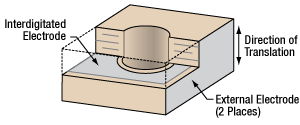
Click to Enlarge
Three-Dimensional Cross Section of Multilayer Piezo with Interdigitated Electrodes (Item # PA4FEH3 Shown); Dashed Lines Indicate Cutaway
| Webpage Features | |
|---|---|
| Clicking this icon below will open a window that contains specifications, mechanical drawings, and graphs. | |
Features
- Sub-Micron Resolution
- Four Sizes Available
- 5.0 mm × 5.0 mm x 2.0 mm with Ø2.0 mm Through Hole
- 5.0 mm × 5.0 mm x 3.0 mm with Ø2.0 mm Through Hole
- 7.0 mm × 7.0 mm x 2.0 mm with Ø3.1 mm Through Hole
- 7.0 mm × 7.0 mm x 3.0 mm with Ø3.0 mm Through Hole
- Custom Size Options Available by Contacting Tech Support
- Drive Voltage Range of 0 - 150 V
- For Use in Open-Loop Setups
- Ideal for Vacuum and OEM Applications
- Flat End Plates Available Separately
Thorlabs' piezoelectric actuators with a central through hole consist of stacked piezoelectric ceramic layers with interdigitated electrodes, as pictured in the diagram to the right. The multilayer design enables high resonant frequencies and sub-millisecond response times, while the use of interdigitated electrodes minimizes the drive voltage range. The central through hole is ideal for laser tuning and micro-dispensing applications. They are available with a drive voltage range of 0 - 150 V; for a complete list of specifications, see the table below.
These compact piezoelectric chips can be easily integrated into systems for precision movement and provide maximum free stroke displacements from 1.8 µm to 3.0 µm. Through a precision grinding process, the accuracy of the design height is ensured to better than ±5 µm. This high accuracy makes it significantly easier to design devices around our piezoelectric chips.
The maximum displacement of these actuators is achieved when they are preloaded with the maximum displacement load, which is specified for each product. The actual value of the maximum displacement varies for each item and must be experimentally determined; however, the maximum displacement will always be larger than the free stroke displacement. Please note that when mounting a load onto the piezoelectric chip, the force should be directed along the actuator's axis of displacement. For more details see the Operation tab.
Each chip has an insulating ceramic layer on four exterior sides and along the interior through hole, which offers better protection against moisture than common epoxy-coated designs. The remaining two sides have screen-printed silver electrodes, to which the drive voltage is applied. For convenience, they are available with pre-attached 75 mm wires.
Thorlabs' piezoelectric chips are individually inspected using a proprietary AI algorithm to ensure the highest quality of our line of piezo chips, actuators, and transducers.
To accommodate a variety of loading conditions, flat ceramic end plates may be purchased as accessories for these chips.
Piezo chips with custom dimensions, voltage ranges, and coatings are available. Additionally, customers can order these piezo chips in high-volume quantities. Please contact Tech Support for more information.
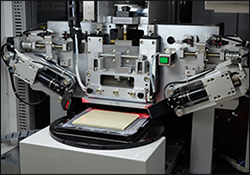
Click to Enlarge
Dicing the PZT Block into Individual Elements
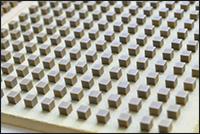
Click to Enlarge
Chips After Binder Burnout and Sintering
Thorlabs' In-House Piezoelectric Manufacturing
Our piezoelectric chips are fabricated in our production facility in China, giving us full control over each step of the manufacturing process. This allows us to economically produce high-quality products, including custom and OEM devices. A glimpse into the fabrication of our piezoelectric chips follows. For more information about our manufacturing process and capabilities, please see our Piezoelectric Capabilities page.
- Build Blocks from Flexible Sheets of Lead Zirconate Titanate (PZT) or BiScO3-PbTiO3 (BSPT) Powder
- Screen Print Electrodes on Each Individual Sheet
- Layer the Printed Sheets One Top of Another
- Consolidate the Layered Sheets in an Isostatic Press
- Dice the Block into Individual Elements
- Purge Solvent and Binder Material Residues by Heat Treating the Elements
- Sinter the Elements to Fuse the Piezoelectric Pressed Powder and Grow PZT or BSPT Crystals
- Lap the Elements to Achieve Tight Dimensional Tolerances: ±5 µm for Each Element
- Screen Print the Outer Electrodes on the Elements
- Align the Individual PZT os BSPT Crystals Along the Same Axis by Poling the Elements
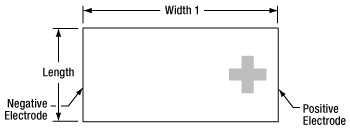
Click to Enlarge
Schematic of PA4FEH3 Piezo Chip
Operation Notes
Power Connections
A positive bias should be applied across the device. The positive electrode should receive positive bias, and the other electrode should be connected to ground. Applying a negative bias across the device may cause mechanical failure. For products that ship with wires attached, the positive wire may be identified in two ways: it is red, as can be seen in the product images, and it is attached to the electrode on the side of the chip indicated by a + mark, as is depicted in the image at right. The wire that should be grounded is black, and it is attached to the electrode on the side of the chip opposite the side with the positive electrode.
Caution: after driving, the piezo is fully charged. Directly connecting the positive and negative electrodes has the risk of electricity discharging, spark, and even failure. We recommend using a resistor (>1 kΩ) between the electrodes to release the charge.
Preloading
The maximum displacement of these actuators is achieved when they are preloaded with the maximum displacement load, which is specified for each product. The actual value of the maximum displacement varies for each item and must be experimentally determined; however, the maximum displacement will always be larger than the free stroke displacement. Preloading increases the length of the actuator's stroke because the poling process performed during fabrication does not align all ferroelectric grains in the piezoelectric material in the same direction. Preloading the actuator mechanically forces many of the mis-aligned grains into a more ideal alignment. Applying a driving voltage across the piezo material causes the orientations of the ferroelectric grains to rotate so they become aligned with the applied field, and this results in a dimensional change of the piezo material. When more ferroelectric grains are initially aligned in the same direction, the dimensional change of the piezo material in response to the applied driving voltage is greater. Preloads greater than the optimal maximum displacement load result in displacements less than the maximum displacement, as higher loads oppose the switching of the grain orientations in response to the applied driving voltage.
Soldering Wire Leads to the Electrodes
If wire leads must be attached or reattached to the electrodes, a soldering temperature no higher than 370 °C (700 °F) should be used, and heat should be applied to each electrode for a maximum of 2 seconds. Solder the lead to the middle of the electrode and keep the region over which heat is applied as small as possible.
Interfacing a Piezoelectric Element with a Load
Piezoceramics are brittle and have low tensile strength. Avoid loading conditions that subject the actuator to lateral, transverse, or bending forces. When applied incorrectly, an external load that may appear to be compressive can, through bending moments, cause high tensile stresses within the piezoelectric device. Improperly mounting a load to the piezoelectric actuator can easily result in internal stresses that will damage the actuator. To avoid this, the piezoelectric actuator should be interfaced with an external load such that the induced force is directed along the actuator's axis of displacement. The load should be centered on and applied uniformly over as much of the actuator's mounting surface as possible. When interfacing the flat surface of a load with an actuator capped with a flat mounting surface, ensure the two surfaces are highly flat and smooth and that there is good parallelism between the two when they are mated.
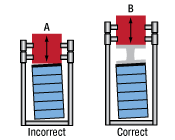
Click to Enlarge
Loads properly and improperly mounted to piezo actuators using a variety of interfacing methods.
To accommodate a variety of loading conditions, flat ceramic end plates may be purchased as accessories for these chips. To attach a load to PZT piezo chips, we recommend using an epoxy that cures at a temperature lower than 80 °C (176 °F), such as our 353NDPK or TS10 epoxies or Loctite® Hysol® 9340. For BiScO3-PbTiO3 (BSPT) piezo chips, we recommend any inorganic adhesive which cures at a temperature lower than 120 °C and has a melting point higher than 250 °C; our 353NDPK epoxy is safe to use, however the strength will be reduced at 250 °C, and therefore a preload should be applied to maintain the mechanical structure. Loads should be mounted only to the faces of the piezoelectric chip that translate. Mounting a load to a non-translating face may lead to the mechanical failure of the actuator. Some correct and incorrect approaches to interfacing loads with piezoelectric actuators are discussed in the following paragraph.
The image at right shows an example of an incorrect (A) and correct (B) approach for interfacing a flat-bottomed, off-axis load with a piezoelectric actuator. Approach A endangers the piezo element by applying the full force of the load to one edge of the element. This uneven loading causes dangerous stresses in the actuator, including a bending moment around the base. In correct approach B, a flexure mount acts as an interface between the off-axis flat mounting surface of the load and the flat mounting plate of the actuator. The flexure mount ensures that the load is both uniformly distributed over the surface plate of the actuator and that the loading force is directed along the translational axis of the actuator.
Operating Under High-Frequency Dynamic Conditions
It may be necessary to implement an external temperature-control system to cool the device when it is operated at high frequencies. The maximum operating temperature of PZT piezos is 130 °C (266 °F), and high-frequency operation causes the internal temperature of the piezoelectric device to rise. For higher temperature applications, BSPT piezos are available with a maximum operating temperature of 250 °C. The dependence of the device temperature on the drive voltage frequency for each product can be accessed by clicking the Info icons, ![]() , below. The temperature of the device should not be allowed to exceed its specified maximum operating temperature.
, below. The temperature of the device should not be allowed to exceed its specified maximum operating temperature.
Estimating the Resonant Frequency for a Given Applied Load
A parameter of significance to many applications is the rate at which the piezoelectric actuator changes its length. This dimensional rate of change depends on a number of factors, including the actuator's resonant frequency, the absolute maximum bandwidth of the driver, the maximum current the piezoelectric device can produce, the capacitance of the piezoelectric actuator, and the amplitude of the driving signal. The length of the voltage-induced extension is a function of the amplitude of the applied voltage driving the actuator and the length of the piezoelectric device. The higher the capacitance, the slower the dimensional change of the actuator.
Quick changes in the applied voltage result in fast dimensional changes to the piezoelectric chip. The magnitude of the applied voltage determines the nominal extension of the chip. Assuming the driving voltage signal resembles a step function, the minimum time, Tmin, required for the length of the actuator to transition between its initial and final values is approximately 1/3 the period of resonant frequency. If there is no load applied to the piezoelectric actuator, its resonant frequency is ƒo and its minimum response time is:

After reaching this nominal extension, there will follow a damped oscillation in the length of the actuator around this position. Controls can be implemented to mitigate this oscillation, but doing so may slow the response of the actuator.
Applying a load to the actuator will reduce the resonant frequency of the piezoelectric chip. Given the unloaded resonant frequency of the actuator, the mass of the chip, m, and the mass of the load, M, the loaded resonant frequency (ƒo') may be estimated:

Estimating Device Lifetime for DC Drive Voltage Conditions
The lifetime of a piezoelectric device is a function of the operating temperature, applied voltage, and relative humidity conditions. Lifetimes are reduced as a consequence of humidity-driven electrolytic reactions, which occur at the electrodes of the piezoelectric devices when a DC voltage is applied. These reactions both generate hydrogen and result in metal dendrites growing from the cathode towards the anode. The hydrogen liberated by the electrolytic reaction chemically reacts with and degrades the piezoelectric material. Dendrites that grow to electrically connect the cathode and anode result in increasing levels of leakage current. Failed piezoelectric devices are defined as those that exhibit leakage current levels above an established threshold.
A ceramic moisture-barrier layer that insulates Thorlabs' piezoelectric devices on four sides is effective in minimizing the effects of humidity on device lifetime. As there is interest in estimating the lifetime of piezoelectric devices, Thorlabs conducted environmental testing on our ceramic-insulated, low-voltage, piezoelectric actuators. The resulting data were used to create a simple model that estimates the mean time to failure (MTTF), in hours, when the operating conditions of humidity, temperature, and applied voltage are known. The estimated MTTF is calculated by multiplying together three factors that correspond, respectively, to the operational temperature, relative humidity, and fractional voltage of the device. The fractional voltage is calculated by dividing the operational voltage by the maximum specified drive voltage for the device. The factors for each parameter can be read from the following plots, or they may be calculated by downloading the plotted data values and interpolating as appropriate.
In the following trio of plots, the solid-line segment of each curve represents the range of conditions over which Thorlabs performed testing. These are the conditions observed to be of most relevance to our customers. The dotted-line extensions to the solid-line segments represent extrapolated data and represent a wider range of conditions that may be encountered while operating the devices.
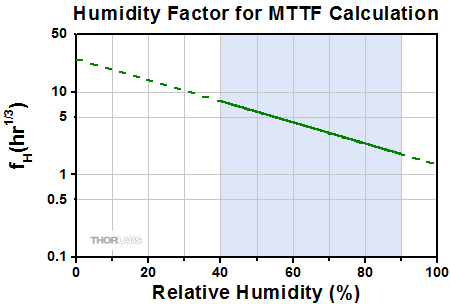
Click to Enlarge
For an Excel file containing these fH vs. relative humidity data, please click here.
The data used to generate these temperature, voltage, and humidity factor plots resulted from the analysis of measurements obtained from testing devices under six different operational conditions. Different dedicated sets of ten devices were tested under each condition, with each condition representing a different combination of operational voltage, device temperature, and relative humidity. After devices exhibit leakage current levels above a threshold of 100 nA, they are registered as having failed. The individual contributions of temperature, humidity, and voltage to the lifetime are determined by assuming:
- MTTF = fV(V) * fT(T) * fH(H)
- A power law dependence for the voltage: fV(V) = A1Vb1
- An exponential relationship for the relative humidity: fH(T) = A2ecH
- An Arrhenius relationship for the temperature: fT(H) = A3eb2/T
where A1, A2, A3, b1, b2, and c are constants determined through analysis of the measurement data, V is the DC operational voltage, T is the device temperature, and H is the relative humidity. Because the MTTF has a different mathematical relationship with each factor, the dependence of the MTTF on each factor alone may be determined. These are the data plotted above. The regions of the above curves marked by the blue shading are derived from experimental data. The dotted regions of the curves are extrapolated.
Lifetime testing of these devices continues, and additional data will be published here as they become available. To assist in temperature control, please see our selection of thermoelectric coolers. Temperature and humidity can be monitored using our USB Temperature and Humidity Logger.
Cleaning for Vacuum Compatibility
When suitable for vacuum applications, Thorlabs' piezo chips have the rated vacuum compatibility specified in their Info Icons (![]() ). While no extra cleaning is needed to achieve this value, we recommend cleaning these products with isopropyl alcohol (IPA) in an ultrasonic immersion tank and then baking them at 60 °C for two hours. Do not immerse the device in other organic solvents.
). While no extra cleaning is needed to achieve this value, we recommend cleaning these products with isopropyl alcohol (IPA) in an ultrasonic immersion tank and then baking them at 60 °C for two hours. Do not immerse the device in other organic solvents.
| Posted Comments: | |
user
(posted 2022-06-13 08:33:03.297) Hi,
I understand that the chip will mainly expand and shrink along the vertical direction (perpendicular to the biasing direction) when we apply a bias, as shown in the photo on the website. Does the chip expand or shrink along the horizontal direction (e.g., direction that is parallel to the biasing direction)? and how much?
Thanks,
Lunjie cdolbashian
(posted 2022-06-17 04:45:54.0) Thanks for contacting Thorlabs. When applying a bias, the chip expand along vertical direction and shrink along the horizontal direction. The shrinkage strain is about half of the expansion strain. For example, under 150V, the vertical expansion is about 1.8μm stroke, 0.09% strain, the horizontal shrinkage would be about 0.045% strain. To further estimate the stroke from the strain, the aperture will not contribute the motion, so we need to exclude it from the horizontal dimension. For a simple estimation, the horizontal shrinkage stroke is about 0.045%*(5-2)mm = 1.35μm. The real stroke may be a little higher because the edge still contribute the motion. In a real test, this stroke is about 1.6μm. alexei.ourjoumtsev
(posted 2019-01-18 13:53:40.36) Hi,
I'm planning to use PA4FKH3 in ultra-high vacuum (~10^-10 torr). The info tab recommends "to clean the part with isopropyl alcohol (IPA) in an ultrasonic immersion tank and then bake it at 60 °C for two hours". On the other hand, the "storage" section of the spec sheet says "Do not immerse the device in organic solvents", to which IPA obviously belongs. Which one should I trust? Is it ok to make a short (~5min) ultrasonic bath in IPA, but not to leave the piezo in IPA for a long time? nbayconich
(posted 2019-02-05 03:31:36.0) Thank you for contacting Thorlabs. My apologies for the confusion, IPA will be fine for an ultrasonic immersion bath as well as general cleaning. The term organic solvents can describe a wide variety of chemicals some not being suitable for use with these piezos. We do not recommend using any organic solvent other than Isopropyl alcohol for cleaning in an immersion tank. |


| Square Flat End Plates with Through Holes | ||||
|---|---|---|---|---|
| Item # | Exterior Dimensions | Through Hole Diameter |
Tolerance | Compatible Piezo Chips |
| PKFEP4H3 | 5.00 mm x 5.00 mm x 0.40 mm | 2.00 mm | ±0.04 mm | PA4FEH3(W), PA4FKH3(W) |
| PKGEP5H5 | 7.00 mm x 7.00 mm x 0.50 mm | 3.00 mm | ±0.04 mm | PA4GEH5(W), PA4GKH5(W) |
- Flat End Plates in Two Sizes
- Spread Force Across Piezo Face at Contact Point
- Sold in Packs of 16 or 25
A selection of flat end plates compatible with the piezo chips above are available separately in two sizes (see the table to the right). Flat end plates are used to spread the force at the contact point over the entire end surface of a piezo chip. When selecting a flat end plate to adhere to a piezo end face, it is important to match the bottom surface area of the plate to the cross section of the piezo in order to ensure that forces are spread evenly over the surface. These flat end plates have a dimensional tolerance of ±0.04 mm.
 Products Home
Products Home
















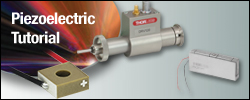
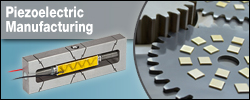
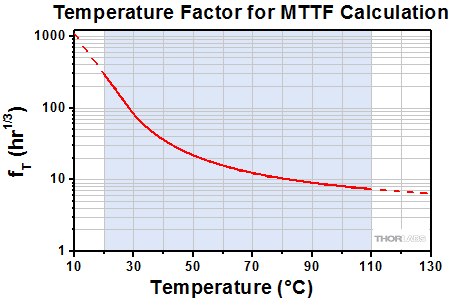
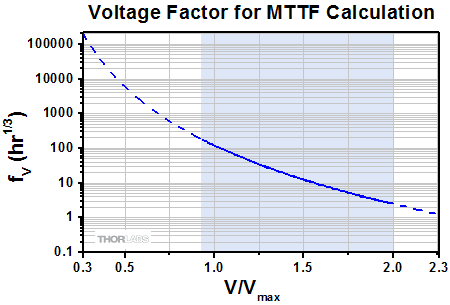
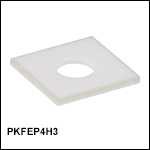
 Zoom
Zoom Piezo Chips with Through Hole, 1.8 - 3.0 µm Travel
Piezo Chips with Through Hole, 1.8 - 3.0 µm Travel